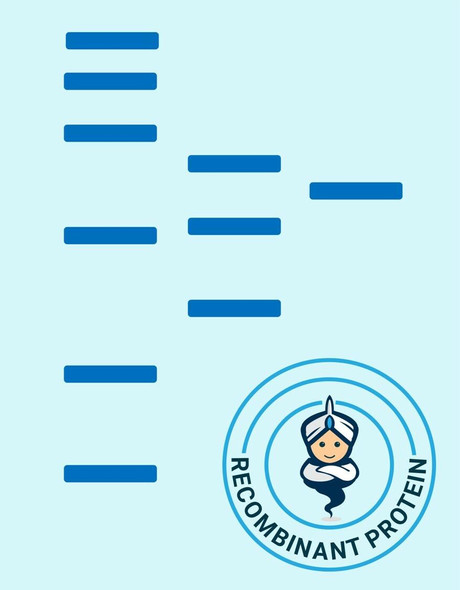Enzymes Recombinant Proteins
Human PDHX Recombinant Protein (RPPB2080)
- SKU:
- RPPB2080
- Product Type:
- Recombinant Protein
- Species:
- Human
- Uniprot:
- O00330
- Research Area:
- Enzymes
Description
| Product Name: | Human PDHX Recombinant Protein |
| Product Code: | RPPB2080 |
| Size: | 10µg |
| Species: | Human |
| Target: | PDHX |
| Synonyms: | DLDBP, E3BP, OPDX, PDX1, proX, Pyruvate Dehydrogenase Complex, Component X, Dihydrolipoamide Dehydrogenase-Binding Protein Of Pyruvate Dehydrogenase Complex, Lipoyl-Containing Pyruvate Dehydrogenase Complex Component X, Pyruvate Dehydrogenase Complex, Lipoyl-Containing Component X, Pyruvate Dehydrogenase Complex, E3-Binding Protein Subunit, Pyruvate Dehydrogenase Protein X Component, Mitochondrial, E3-Binding Protein. |
| Source: | Escherichia Coli |
| Physical Appearance: | Sterile Filtered clear solution. |
| Formulation: | PDHX protein solution (0.25mg/ml) containing Phosphate buffer saline (pH 7.4) and 20% glycerol, 1mM DTT. |
| Stability: | Store at 4°C if entire vial will be used within 2-4 weeks. Store, frozen at -20°C for longer periods of time. For long term storage it is recommended to add a carrier protein (0.1% HSA or BSA).Avoid multiple freeze-thaw cycles. |
| Purity: | Greater than 85.0% as determined by SDS-PAGE. |
| Amino Acid Sequence: | MGSSHHHHHH SSGLVPRGSH MGSGDPIKIL MPSLSPTMEE GNIVKWLKKE GEAVSAGDAL CEIETDKAVV TLDASDDGIL AKIVVEEGSK NIRLGSLIGL IVEEGEDWKH VEIPKDVGPP PPVSKPSEPR PSPEPQISIP VKKEHIPGTL RFRLSPAARN ILEKHSLDAS QGTATGPRGI FTKEDALKLV QLKQTGKITE SRPTPAPTAT PTAPSPLQAT AGPSYPRPVI PPVSTPGQPN AVGTFTEIPA SNIRRVIAKR LTESKSTVPH AYATADCDLG AVLKVRQDLV KDDIKVSVND FIIKAAAVTL KQMPDVNVSW DGEGPKQLPF IDISVAVATD KGLLTPIIKD AAAKGIQEIA DSVKALSKKA RDGKLLPEEY QGGSFSISNL GMFGIDEFTA VINPPQACIL AVGRFRPVLK LTEDEEGNAK LQQRQLITVT MSSDSRVVDD ELATRFLKSF KANLENPIRL A |
Pyruvate Dehydrogenase Complex, Component X, also known as PDHX, encodesthe E3 binding protein subunit of the PDH complex which contains 3 catalyticsubunits. PDHX tethers E3 dimers to the E2 core of the pyruvate dehydrogenasecomplexes of eukaryotes. This specific binding is critical for a functional PDHcomplex.
PDHX Human Recombinant produced in E.Coli is a single, non-glycosylated polypeptide chain containing 471 amino acids (54-501 a.a) and having a molecular mass of 50.4kDa. PDHX is fused to a 23 amino acid His-tag at N-terminus & purified by proprietary chromatographic techniques.
| UniProt Protein Function: | PDHX: a mitochondrial protein required for anchoring dihydrolipoamide dehydrogenase (E3) to the pyruvate dehydrogenase complexes (PDHC) of eukaryotes. This specific binding is essential for a PDHC function. Eukaryotic pyruvate dehydrogenase complexes are organized about a core consisting of the oligomeric dihydrolipoamide acetyl-transferase (E2), around which are arranged multiple copies of pyruvate dehydrogenase (E1), dihydrolipoamide dehydrogenase (E3), and protein X bound by non-covalent bonds. Belongs to the 2-oxoacid dehydrogenase family. Contains 1 lipoyl-binding domain. |
| UniProt Protein Details: | Protein type:Mitochondrial Chromosomal Location of Human Ortholog: 11p13 Cellular Component: mitochondrial matrix Molecular Function:transferase activity, transferring acyl groups Biological Process: cellular metabolic process; regulation of acetyl-CoA biosynthetic process from pyruvate; pyruvate metabolic process Disease: Pyruvate Dehydrogenase E3-binding Protein Deficiency |
| NCBI Summary: | The pyruvate dehydrogenase (PDH) complex is located in the mitochondrial matrix and catalyzes the conversion of pyruvate to acetyl coenzyme A. The PDH complex thereby links glycolysis to Krebs cycle. The PDH complex contains three catalytic subunits, E1, E2, and E3, two regulatory subunits, E1 kinase and E1 phosphatase, and a non-catalytic subunit, E3 binding protein (E3BP). This gene encodes the E3 binding protein subunit; also known as component X of the pyruvate dehydrogenase complex. This protein tethers E3 dimers to the E2 core of the PDH complex. Defects in this gene are a cause of pyruvate dehydrogenase deficiency which results in neurological dysfunction and lactic acidosis in infancy and early childhood. This protein is also a minor antigen for antimitochondrial antibodies. These autoantibodies are present in nearly 95% of patients with the autoimmune liver disease primary biliary cirrhosis (PBC). In PBC, activated T lymphocytes attack and destroy epithelial cells in the bile duct where this protein is abnormally distributed and overexpressed. PBC eventually leads to cirrhosis and liver failure. Alternative splicing results in multiple transcript variants encoding distinct isoforms.[provided by RefSeq, Oct 2009] |
| UniProt Code: | O00330 |
| NCBI GenInfo Identifier: | 12643417 |
| NCBI Gene ID: | 8050 |
| NCBI Accession: | O00330.3 |
| UniProt Related Accession: | O00330 |
| Molecular Weight: | |
| NCBI Full Name: | Pyruvate dehydrogenase protein X component, mitochondrial |
| NCBI Synonym Full Names: | pyruvate dehydrogenase complex component X |
| NCBI Official Symbol: | PDHX�� |
| NCBI Official Synonym Symbols: | E3BP; OPDX; PDX1; proX; DLDBP; PDHXD�� |
| NCBI Protein Information: | pyruvate dehydrogenase protein X component, mitochondrial |
| UniProt Protein Name: | Pyruvate dehydrogenase protein X component, mitochondrial |
| UniProt Synonym Protein Names: | Dihydrolipoamide dehydrogenase-binding protein of pyruvate dehydrogenase complex; E3-binding protein; E3BP; Lipoyl-containing pyruvate dehydrogenase complex component X; proX |
| Protein Family: | Pyruvate dehydrogenase complex |
| UniProt Gene Name: | PDHX�� |
| UniProt Entry Name: | ODPX_HUMAN |






